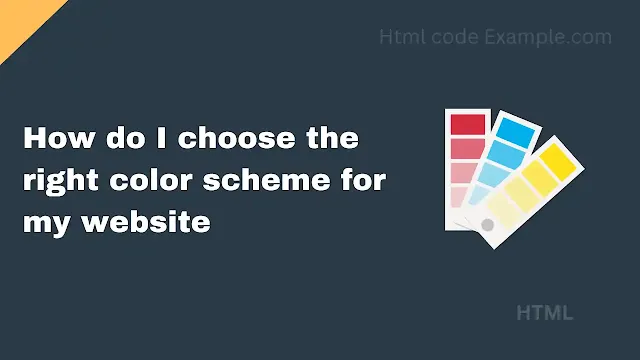Ever landed on a website that instantly felt right? Chances are, the color scheme had a lot to do with it. Colors can set a mood, tell a story, and—even better—convert visitors into loyal customers.
But if choosing colors feels like shooting in the dark, you're not alone. Let's walk through how to choose the perfect color palette, complete with real examples, color codes, and tips you can actually use.
Why the Right Color Scheme Matters
Colors affect emotion and perception.
Whether you're building a portfolio, online store, or blog, your color palette will:
- Shape first impressions within milliseconds
- Create trust or make users bounce
- Guide navigation through visual hierarchy
- Strengthen your branding across platforms
It's more than decoration—it's communication.
Step 1: Define Your Brand Personality
Start by asking:
What should people feel when they visit your site?
Here are common brand personalities and matching color themes:
| Personality | Mood | Recommended Colors |
|---|---|---|
| Professional | Trust, order | Blue, gray, white |
| Playful | Energetic, fun | Yellow, orange, teal |
| Natural/Organic | Calm, earthy | Green, brown, beige |
| Creative/Artistic | Bold, expressive | Purple, pink, navy |
| Luxury | Elegant, exclusive | Black, gold, deep burgundy |
Step 2: Understand Color Psychology with HEX Codes
Here's a deeper look at color psychology and hex codes you can use:
| Color | Emotion | Common Use | Example HEX |
|---|---|---|---|
| Blue | Trust, calm | Finance, tech | #1E90FF, #0F4C81 |
| Red | Passion, urgency | Sales, food | #FF5733, #C70039 |
| Green | Nature, peace | Health, organic | #88B04B, #006400 |
| Yellow | Optimism, youth | Startups, kids | #FFD700, #F4C542 |
| Black | Sophistication | Luxury, fashion | #000000, #1C1C1C |
| White | Simplicity | Minimalist, tech | #FFFFFF, #F5F5F5 |
| Purple | Creativity | Art, beauty | #800080, #9B59B6 |
Use these as a foundation to build your scheme.
Step 3: Pick a Primary, Secondary & Accent Color
A great website typically has 3-4 core colors:
- Primary – Most used (e.g., headers, buttons)
- Secondary – Used to support the main color
- Accent – Used sparingly for highlights or CTAs
- Neutral – White, black, gray for backgrounds or text
Example 1: Organic Skincare Brand Website
Brand Goal: Calm, clean, earthy
Color Scheme:
- Primary: Sage Green –
#A8BDB2 - Secondary: Sand Beige –
#EAE0D5 - Accent: Clay Terracotta –
#D49A89 - Neutral: Off-white –
#FDFDFD
Why it works: These soft, muted colors feel natural and trustworthy. They suggest purity and sustainability, which is exactly what a skincare brand needs.
Usage Tip: Use sage green for buttons and headings, beige for backgrounds, and terracotta for hover states or call-to-action (CTA) buttons.
Example 2: Tech Startup Website
Brand Goal: Innovative, modern, trustworthy
Color Scheme:
- Primary: Electric Blue –
#1E90FF - Secondary: Slate Gray –
#2F4F4F - Accent: Neon Green –
#39FF14 - Neutral: Soft Black –
#1A1A1A
Why it works: The blue signals reliability, the neon adds modern energy, and the slate keeps things grounded.
Usage Tip: Use electric blue for CTAs and logos, neon green for icons or hover animations, and a dark background for that sleek, high-tech look.
Example 3: Food Blog Website
Brand Goal: Warm, delicious, inviting
Color Scheme:
- Primary: Spicy Orange –
#E07A5F - Secondary: Olive Green –
#81B29A - Accent: Cream –
#F4F1DE - Neutral: Deep Brown –
#3D2C2E
Why it works: These warm tones are literally appetizing! Perfect for recipes, storytelling, and cozy blog vibes.
Usage Tip: Use orange for section titles, green for buttons, cream for backgrounds, and brown for text and footers.
Step 4: Ensure Contrast & Accessibility
This step is critical. Even beautiful colors can ruin UX if they're hard to read.
Use these tools to test contrast:
Pro Tip: For accessibility:
- Aim for a contrast ratio of 4.5:1 for normal text
- Use dark text on light backgrounds (or vice versa)
Step 5: Use Tools to Build Palettes
You don't need to guess—try these to build and preview palettes:
- 🔹 Coolors.co – Generates matching color schemes
- 🔹 Adobe Color – Explore color theory options (triadic, analogous, complementary)
- 🔹 Canva Color Palette Generator – Upload an image and pull colors from it
Step 6: Review Competitor Color Strategies
Look at brands in your niche and reverse-engineer their palettes. Ask:
- What emotions do their colors trigger?
- Are they too loud or too dull?
- How can I stand out while staying relevant?
Example: Apple's clean, grayscale palette speaks to simplicity and tech elegance. If you're also targeting premium tech users, you might echo that vibe—but introduce your own accent twist, like a bright cyan or coral.
Mistakes to Avoid
- ❌ Overcomplicating with 6+ colors
- ❌ Using all bold colors—no balance
- ❌ Skipping contrast checks
- ❌ Forgetting mobile displays
- ❌ Ignoring colorblind users (use patterns/icons to supplement colors)
Bonus: 3 Plug-and-Play Color Palettes
Here are ready-made, high-performing color palettes you can steal (or tweak):
🌱 Modern Nature Brand
- Forest Green:
#2A6041 - Light Moss:
#A3B18A - Cream:
#F0EFEB - Bark Brown:
#3D3D3D
🎨 Creative Portfolio
- Indigo Purple:
#5D3FD3 - Hot Pink:
#FF69B4 - Cloud White:
#FAFAFA - Deep Navy:
#1B1F3A
📈 Fintech Company
- Steel Blue:
#4682B4 - Icy White:
#F8F9FA - Carbon Black:
#121212 - Signal Orange:
#FF6F00
Final Thoughts: Let Your Colors Tell the Story
Your color scheme isn't just decoration—it's your visual voice. Done well, it can boost trust, highlight calls-to-action, and even increase conversions.
Start with your brand's personality, then build a palette that supports it emotionally and visually. With the right balance of color theory, psychology, and real examples, you'll design a site people remember—and return to.
